As in Part 1 of this series, I will continue with the Introduction section of Ryan’s plan. Ryan continues with his ideology that progressives are expanding a culture of government dependency. Ryan states:
Equally troubling has been the effect on national character. Until recently, Americans were known and admired everywhere for their hopeful determination to assume responsibility for the quality of their own lives; to rely on their own work and initiative; and to improve opportunities for their children to prosper in the future. But over time, Americans have been lured into viewing government – more than themselves, their families, their communities, their faith – as their main source of support; they have been drawn toward depending on the public sector for growing shares of their material and personal well-being. The trend drains individual initiative and personal responsibility. It creates an aversion to risk, sapping the entrepreneurial spirit necessary for growth, innovation, and prosperity. In turn, it subtly and gradually suffocates the creative potential for prosperity.
Now America is approaching a “tipping point” beyond which the Nation will be unable to change course – and this will lead to disastrous fiscal consequences, and an erosion of economic prosperity and the American character itself. The current administration and Congress are propelling the Nation to the brink of this precipice.
This is a recurring theme for Paul Ryan. Ryan does not cite any data that progressives have corrupted substantial portions of Americans for not assuming “responsibility for the quality of their own lives”, failing to “rely on their own work and initiative”, not caring about wanting to “improve opportunities for their children to prosper in the future”, draining “individual initiative and personal responsibility”, creating an “aversion to risk”, “sapping the entrepreneurial spirit” and suffocating “the creative potential for prosperity”. He states these articles of faith as self-evident. I am sure that anecdotal examples of government dependency can be found to reinforce his position but his assertion here is that progressives have pushed us more and more to the “tipping point”, the “brink” of the “precipice”. This doomsday style of discussion was exhaustively and highly overused by the Bush administration to convince the American public of the need for two wars and for TARP. Alarmist rhetoric dismisses the need for evidence based on the need for expediency. While this may be warranted at times, it can also be used as a ploy for negating critical thinking. In retrospect, Iraq was called a mistake by many in the Bush administration, Afghanistan is still a hard sell with the American public and TARP has been questioned by the most ardent market fundamentalists. Likewise, it may be that Ryan is right about progressives pushing American to the brink or it may be merely a rhetorical ploy to adopt the faith of progressive fatalism in haste. There could also be another physiological explanation as I discussed in The Conservative and Liberal Brain. This is more evidence that the Ryan Plan is intended more for propaganda than a real economic plan but let’s not jump to conclusions; let’s let the reading play itself as it will.
In the section, “Public Policy: A Larger and More Intrusive Government”, Ryan continues with the theme of an ongoing progressive plan from the New Deal and the Great Society to destroy America. Here are the current cases that he cites:
Fiscal ‘Status.‘ With the slippery promise of “saving or creating” three-and-a-half million jobs, the Majority passed a $787-billion “stimulus” bill that failed to halt the rise in unemployment, but did include numerous policy changes consistent with the big-government agenda. By expanding Medicaid – a program in desperate need of reform – and launching a new “comparative effectiveness” health program, the bill started the movement away from patient-centered medical care and toward the planned government takeover of the health care sector. The “stimulus” also heaped another $1 trillion in debt onto the taxpayers’ already large burden.
The legislation rested on the Keynesian-inspired notion that government can somehow “manage” a free-market economy, commanding it to grow with heavy doses of borrowed money. All the measure really did was set off a weak and temporary spike in consumer spending, while unemployment continued to rise. Worse, the heavy borrowing used, unsuccessfully, to “prime” the economic pump drained resources the economy will need for sustained growth. Yet the House refused to accept reality, and in December 2009 poured another $150 billion into this failed economic doctrine.
The stimulus bill Ryan criticizes as failing “to halt the rise in unemployment” is wrong according to the real, actual data. Unemployment data does show a reversal of the increase in unemployment since the Obama has been in office. All the following charts can be found here: [NOTE 1]
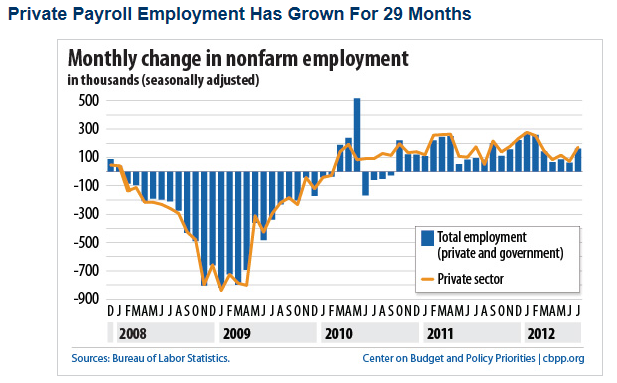
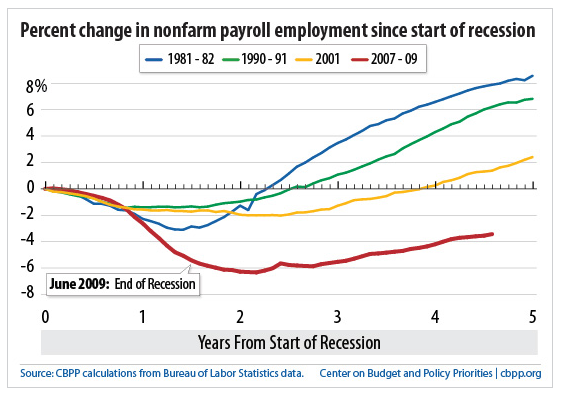
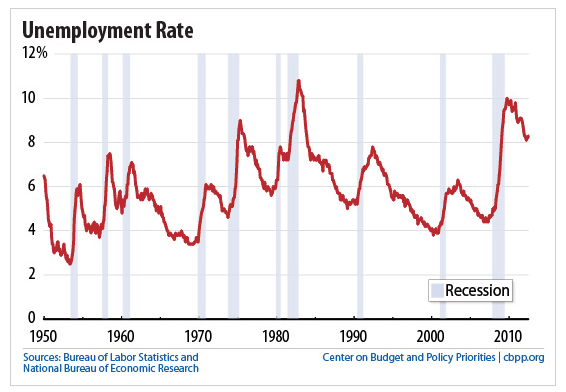
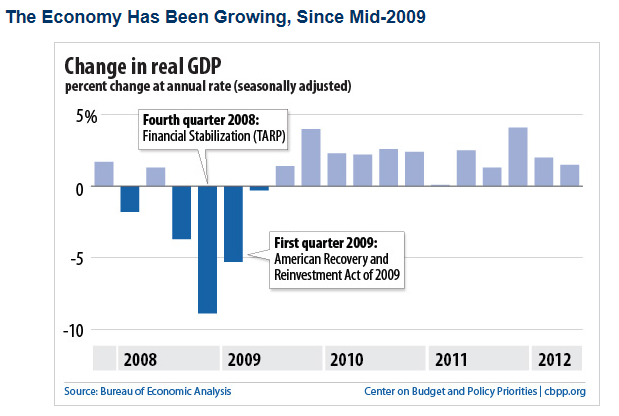
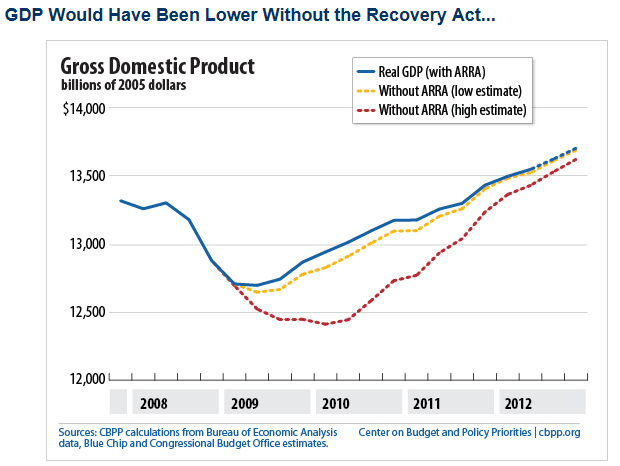
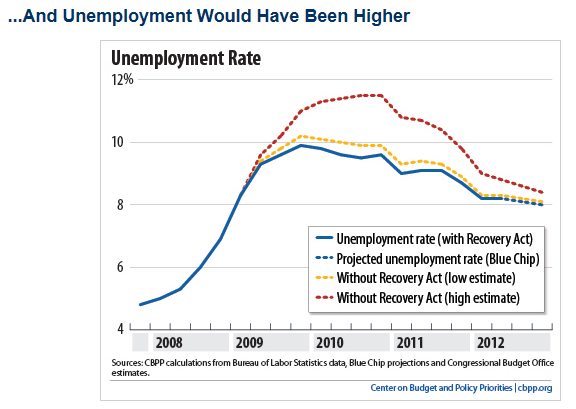
Additionally, Ryan characterizes the Affordable Care Act as “the bill started the movement away from patient-centered medical care and toward the planned government takeover of the health care sector”. This ignores the almost exact similarity to the championed Republican plan that Bill Cassidy (R-LA) proposed during the debate (see Health Care in Louisiana and Massachusetts-Bobby Jindal and Bill Cassidy). Also, Ryan states that “The “stimulus” also heaped another $1 trillion in debt onto the taxpayers’ already large burden.” But a few sentences earlier he stated the stimulus was “$787-billion”. Even if you add the $150 billion dollar amount he cites latter the difference is still 63 billion dollars. Maybe the difference of $63 billion dollars is not real money for Ryan but most folks would have a hard time conveniently glossing over that amount of money. Again the gloss is for rhetorical affect.
Ryan goes on to state that
“The legislation rested on the Keynesian-inspired notion that government can somehow “manage” a free-market economy, commanding it to grow with heavy doses of borrowed money. All the measure really did was set off a weak and temporary spike in consumer spending, while unemployment continued to rise.”
Here he ties the neoclassical economic theory of John Maynard Keynes adopted by most conservative economists and politicians until recent history to a state managed economy with the implication being like communism. Without getting into the differences in the Ayn Rand [NOTE 2] inspired market fundamentalism of the present day with neoclassical economics, suffice it to say that from the chart above, an increase in GDP that resulted from the stimulus also resulted in an increase in government revenue. All economists recognize that growth can erase a mountain of deficit sins from the revenue side. Both Republicans and Democrats have used this reasoning to justify deficit spending for MANY decades.
The bump in GDP shown above also increases federal, state, local and regional tax revenue. In fact, fiscal stimulation is all about ‘stimulating’ GDP and consumer spending – growth, such that the increase in revenues offset the initial expense of the stimulus. One argument made by Republicans for defense spending is based on the growth in the economy that results. The growth in the 90s left us with four years of a budget surplus at the end of the Clinton administration, even with higher taxes, which resulted in huge revenue increases for the government. “Stimulus’ spending can be another word for investment in the economy. This is exactly what Keynes argued and has been accepted by conservatives and liberals for most of the history of the United States. The recent thinking that Ryan subscribes to in Ayn Rand styled, market fundamentalism has been discredited by most economists except marginal schools like the Austrian School. [NOTE 3]
Ryan continues his diatribe against the “intrusive government’:
TARP extension. The Troubled Asset Relief Program [TARP] was intended to thaw credit markets that seized up during the financial crisis – and it succeeded in its short-term objective. But it has now morphed into a $700-billion fund for whatever interventions the administration desires. These have included buying shares of two U.S. auto companies, launching new housing programs, and bailing out large insurance companies – in other words, effecting further transformation of America’s free-market economy.
In the latest version of the administration’s exploitation of TARP for purposes other than stabilizing financial markets, the House – with the President’s blessing – claimed to offset $75 billion in additional “stimulus” spending with a reduction in TARP authority. This move ignored carefully wrought statutory instructions to protect the taxpayer and not use authority to offset new spending. The package further enshrined TARP as Washington’s latest slush fund.
The TARP fund established by President Bush and his Treasury Secretary, Henry Paulson, was initially authorized for $700 billion dollars. However, the Dodd–Frank Wall Street Reform and Consumer Protection Act, harshly criticized by Republicans and Ryan, reduced the amount authorized to $475 billion. As the CBO report below shows $244 billion dollars has already been repaid. Only $11 billion has been written off to date. Total disbursements to date, beyond the CBO report cited below, are $431 billion dollars.
TARP is hardly reflection of nation destroying progressivism. It is sheer lunacy to blame TARP on progressives since it was created by Republicans. Only $80 billion was disbursed to the auto industry and $29 billion has already been paid back. The lions share went to banks under the Bush administration. These kinds of bailouts are hardly new, i.e., the Chrysler bailout in 1979, railroad bailouts starting in World War 1, Lockheed in 1971, savings and loans starting in 1974, and the LDS Debt Crisis during the Reagan administration. All bailouts in American history have been supported by Democrats and Republicans. There is no new destruction of American culture and crippling government dependency by progressives that can rationally be maintained in historical bailouts. Yet, rhetoric is not rational, it is emotional. So far, the data to backup Ryan’s claims has been lacking but the emotional appeal has been zealous and fervent.
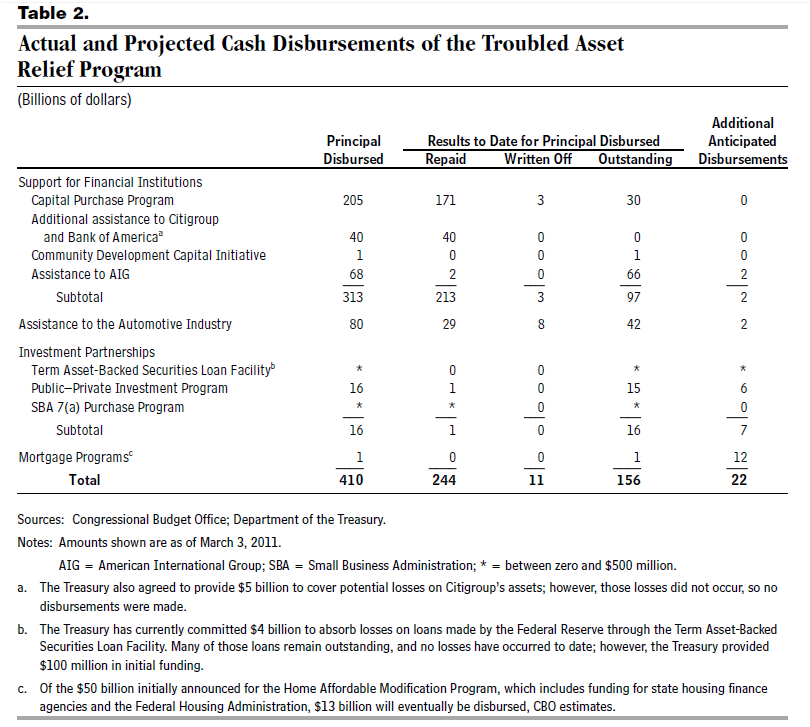
Enough data for now, in the next part, I will start with Ryan’s comment on Cap and Trade.
………………………………………..
[NOTE 1] Here are more link for this data:
http://cbo.gov/sites/default/files/cbofiles/attachments/ARRA_One-Col.pdf
http://cbo.gov/sites/default/files/cbofiles/attachments/02-22-ARRA.pdf
http://cbo.gov/sites/default/files/cbofiles/attachments/11-22-ARRA.pdf
[NOTE 2] It is interesting that Rand took her inspiration from Nietzsche and Ryan thinks of Rand as a thinker or writer that laid out the “moral case for capitalism” (2005 Atlas Society event) better than anyone else. Here morality in any commonly recognizable form, especially by Christianity which Nietzsche harshly criticized, would not characterize Rand’s personal life which most would call hedonistic, her contempt for those not worthy of elitism, her rabid support of abortion to control the despicable masses and her unmitigated intellectual arrogance to the point of a totalitarian, secret, elite cult she headed up in New York during her life (that Alan Greenspan was intimately involved in by the way). When Ryan uses the word “moral” and Rand together to describe the best possible case for capitalism it affirms the worst possible notions of vulture capitalism for anyone familiar with Rand’s philosophy. It would certainly qualify as a “code” word to lull the Christian, fundamentalist sheep into a false sense of market well being while alerting the intellectual elite as to where he is really coming from. Nietzsche, the author of Beyond Good and Evil, would have no patience with altruistic, moral sheepishness. He simply looked at it as a tool that priests used to manipulate their flock.
[NOTE 3] See these discussions:
https://www.mixermuse.com/blog/2012/07/08/fundamentalism-in-market-economy-the-austrian-school/